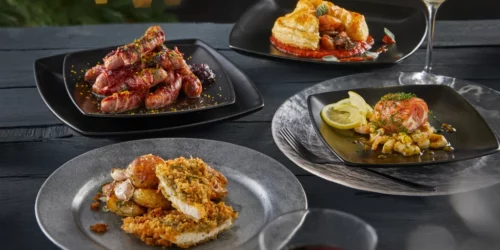There’s no denying it, food waste is a huge problem – and not just in the world of catering. In our homes, we’re responsible for throwing away multiple pounds of untouched food each week, with younger members of the family watching and learning these bad habits.
But food wastage isn’t a UK issue – it’s a global problem. It doesn’t just happen in the home, either. Staggeringly, 30% of the total food supply is lost or wasted globally. Meanwhile, food waste from households, food manufacture, retail, wholesale, hospitality and foodservice totals 12m tonnes in the UK, according to a dedicated Tackling Food Waste Report.
Preventing Food Waste is Key
So, what can be done? Redirecting wasted food is good but preventing food waste in the first instance has got to be better.
When we look at the supply chain in general, there’s lots that can be improved upon, with Paul Trudgian, who runs a supply chain consultancy, saying: “Sustainability is the supply chain trend that’s here to stay. Supply chains are chasing sustainability, in industry, farming, and manufacturing. The onus is on both consumers and producers. It’s also on everyone in the supply chain in between.
In this piece, Paul makes a case for a zero waste supply chain, highlighting the strides that big names like Unilever are already taking.
“However, this isn’t just about being seen to do the right thing.” continues Paul, “This is seeing for ourselves that we are doing the right thing, and why doing so is beneficial for a large number of reasons, including business success.”

Lack of knowledge responsible for food wastage
He goes on to say that visibility is key to sustainability. “We’ve hidden behind a lack of knowledge about where our waste truly ends up. However, it’s time to face the facts, introduce seamless visibility, and address the issue of waste.
By starting small – and starting now – we can all do our bit to reduce waste. By using resources more efficiently, says Paul, you can increase value – not just to the customer, but to your own competitive advantage.
Unilever purchase over two million tonnes of plastic per year. But the company is committed to meeting various packaging goals by 2025, states Green Biz. It plans to make all its packaging recyclable, compostable or reusable. It’ll use 25% of recycled plastic in its plastic packaging and cut the waste associated with the disposal of its products by half.
Forward-thinking
Meanwhile, Radnor Hills, which traditionally sold water in plastic bottles, has launched h20 in cans.
James Byatt, Business Development Manager at the brand is proud to work for such a forward-thinking company, with a strong zero waste policy. He says: “Our goal is to grow our business effectively, whilst enhancing the rural countryside environment within which we work.”
The brand aims to increase the amount of recycled material in its products and packaging, which James said is a strategy that is reinforced by creating a closed loop system with suppliers. “We are proud to send zero of our waste to landfill and our goal is to maintain this status.”
The team says: “Segregating your recyclable materials into their rightful places; (cardboard, clear plastic, cartons, glass and aluminium) and having the facility to burn your non-recyclables for refuse-derived fuel (RDF) is a great way to take your first steps in becoming a zero waste site”

920,00 tonnes of food is thrown away every year
The food waste report from Manchester-based The University Caterers Organisation (TUCO) also highlights the importance of reducing waste. After all, ‘foodservice and hospitality companies throw away 920,000 tonnes of waste every year, about 13% of which is generated in the education sector.’
Here are a some more enlightening facts we pulled directly from the report. In this instance, we look at facts and figures gained from students and those working in university catering, but the issue is rife across the industry:
- 56% of those surveyed, taken during a combination of focus groups and interviews amongst managers and chefs, said portion sizes were too big, with 48% not clearing their plate
- It’s £7.50 per kg to recycle food waste, with caterers admitting that every idea they’ve thought of to ‘do things differently’ has cost money
- 56% in operations and logistics were unhappy with the way food waste is collected
- 74% would like to see new regulations within the industry
- 95% suggested that sharing best practice would help the industry on a whole.
The takeaway tip from the report was this: ‘analyse where your food waste is coming from, using technology where appropriate, and use this data to target your waste hotspots.’
Think innovatively
But there is so much more that can be done – and it really comes down to thinking a little innovatively.
In Helsinki, for instance, Restaurant Nolla works with its suppliers to deliver food without packaging. It also serves a set menu to ensure it doesn’t order too much food and sends customers home with homemade compost. With the goal to eliminate waste, the restaurant is breaking boundaries – interestingly, there isn’t even a rubbish bin in its kitchen.
For those who’d like to buck the trend, too, Vogue has prepared a handy guide to the UK’s own zero waste restaurants, with Brighton’s Silo leading the way. Like Restaurant Nolla it composts its leftovers. But the team goes a step further, crushing waste glass for their local potter to make into beautiful ceramics for its diners.
Elsewhere in the guide, other pioneering zero waste restaurants are:
- serving menus with vegetables as the focus, using fermentation and fire to flavour the food and cook it
- using leftovers to create drinking and cooking vinegars, veg stocks and botanical cocktails
- creating menus centred around a single ingredient
- making cold-pressed juices from mis-shaped fruits and vegetables that are rejected by other eateries
- maintaining their own greenhouses outside, avoiding transport, packaging and oversupply and allowing customers to see exactly what’s going on their plate.
Plenty more where that came from
Of course, there are further opportunities to reduce waste during every part of the supply chain. These include:
- making use of imperfect produce
- encouraging creativity amongst staff when it comes to using leftovers
- downloading dedicated apps which help catalogue caterers’ pantries to ensure food is cooked and plated up well within its use-by date
- ensuring there is better integration between catering software and wholesalers, saving caterers hours of work and ensuring food wastage soon becomes a thing of the past.
So, now is the time for you to consider how you might get involved and go ‘Zero Waste’ in your own kitchen.




